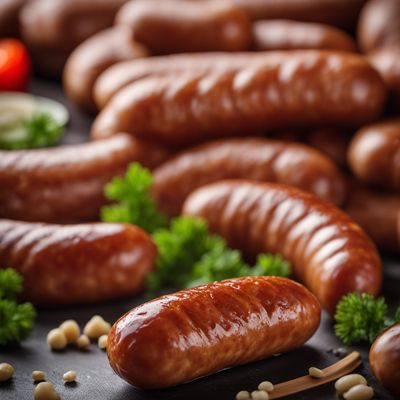
Ingredient
Preserved or partly preserved sausages
The Savory Delight: Preserved Sausages
Preserved or partly preserved sausages come in a variety of forms, including salami, chorizo, and pepperoni. They are characterized by their rich, savory flavors, firm texture, and distinct aromas. These sausages have a long history and are enjoyed in many cultures around the world as a delicious addition to sandwiches, pizzas, and charcuterie boards.
Origins and history
Preserved sausages have a long history that dates back to ancient times. They were developed as a way to preserve meat before the advent of refrigeration. Different regions have their own traditional methods of preparing and flavoring sausages, resulting in a wide variety of styles and flavors. Preserved sausages are often associated with European cuisines, particularly in countries like Italy, Spain, and Germany.
Nutritional information
Preserved sausages are a good source of protein and essential nutrients such as iron, zinc, and vitamin B12. However, they are also high in sodium and saturated fats, so they should be consumed in moderation as part of a balanced diet.
Allergens
Preserved sausages may contain allergens such as wheat, soy, or dairy, depending on the specific recipe and ingredients used. It is important to read the labels carefully and check for any potential allergens before consuming.
How to select
When selecting preserved sausages, look for products that are well-packaged and properly sealed. Check the expiration date and ensure that the sausages are stored at the recommended temperature. If purchasing from a deli or butcher, ask for recommendations and choose sausages that are freshly sliced or prepared.
Storage recommendations
To maintain the freshness and quality of preserved sausages, store them in a cool, dry place. Once opened, wrap them tightly in plastic wrap or store them in an airtight container in the refrigerator. Properly stored, preserved sausages can last for several weeks.
How to produce
Producing preserved sausages at home requires specialized equipment and knowledge of the curing and smoking process. It is recommended to leave the production of preserved sausages to professional butchers or charcuterie experts.
Preparation tips
Preserved sausages can be enjoyed in various ways. They can be sliced and eaten as a snack, added to sandwiches or pizzas, or used as a flavorful ingredient in pasta dishes, stews, or soups. They can also be paired with cheese, olives, and other cured meats to create a delicious charcuterie board.
Culinary uses
Preserved sausages are commonly used in European cuisines, particularly in dishes like salami sandwiches, Spanish tapas, or German sausages with sauerkraut. They are also popular in Italian cuisine, where they are used in pasta dishes, pizzas, and antipasti platters.
Availability
Preserved sausages are commonly available in Europe, particularly in countries like Italy, Spain, and Germany. They can also be found in specialty stores or gourmet markets in other parts of the world.
More ingredients from this category

Cooked sausages (generic)
Savory Delights: Exploring the World of Cooked Sausages

Cured unripened raw sausages
Savory Delights: Exploring Cured Unripened Raw Sausages

Cured ripened raw sausages
The Flavorful Delicacy: Cured Ripened Raw Sausages

Pre-cooked sausages to be cooked before consumption
Savory Links: Unlocking the Flavorful World of Pre-cooked Sausages